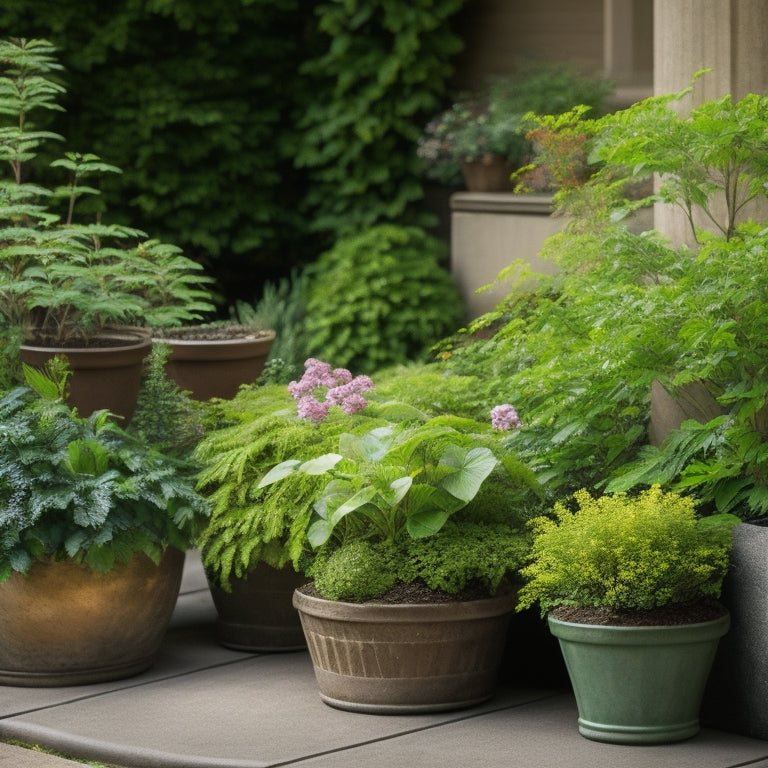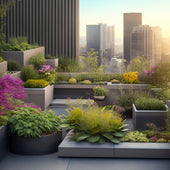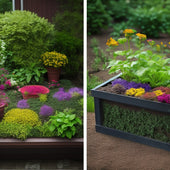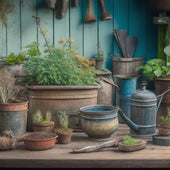
Why Choose Block Planters for Shade Gardens Only
Share
When designing a shade garden, you deliberately choose block planters over other options because they offer unparalleled durability, clever soil and drainage solutions, and endless aesthetic possibilities that elevate your outdoor space. By selecting weather-resistant materials and implementing effective drainage systems, you create a stable environment for your plants to thrive. Block planters also provide control over soil quality and moisture levels, making maintenance a breeze. Plus, their versatility in design allows you to experiment with textures, colors, and arrangements that add depth and visual interest to your shade garden. Now, explore the nuances that make block planters the ideal choice for your shade haven.
Key Takeaways
• Block planters offer superior durability and weather resistance, ideal for shaded areas prone to moisture and humidity.
• They provide better control over soil quality and moisture levels, perfect for shade-loving plants with specific requirements.
• Block planters enable easy maintenance, with built-in water reservoirs and reduced need for fertilization, pruning, and pest management.
• They add visual interest and depth to shade gardens, with a wide range of design possibilities and textures to choose from.
• Block planters create a stable environment for plant health, with effective drainage solutions and protection from waterlogged soil.
Block Planter Durability Matters
When selecting block planters for your shade garden, you'll want to prioritize durability, as a single cracked or crumbling planter can compromise the entire structure and lead to costly repairs or replacements. A durable planter is vital to withstand the elements and maintain its structural integrity over time.
Look for planters made from materials with high weather resistance, such as concrete, stone, or recycled plastic. These materials can withstand harsh weather conditions, including extreme temperatures, heavy rainfall, and intense sunlight.
Material longevity is also important. A planter that can resist degradation and corrosion will require less maintenance and replacement. Consider planters with a protective coating or sealant to enhance their weather resistance.
Additionally, inspect the planter's construction and joints for any signs of weakness or vulnerability. A well-constructed planter with a solid foundation will provide a stable base for your plants to thrive.
Soil and Drainage Considerations
As you focus on building a thriving shade garden, you'll need to take into account the soil and drainage requirements of your plants, guaranteeing that your block planters provide the ideal environment for healthy root growth and water management.
When it comes to soil composition, you'll want to select a mix specifically designed for shade plants, with a pH between 6.0 and 7.0. This will allow your plants to absorb essential nutrients and thrive.
To prevent waterlogged soil, you'll need to implement effective drainage solutions. One approach is to add a 2-3 inch layer of coarse gravel or broken pottery at the bottom of your planter. This allows excess water to drain quickly, reducing the risk of root rot and other problems.
Additionally, consider incorporating a drainage hole or two in the planter itself to guarantee excess water can escape. By carefully controlling soil and drainage, you'll create a stable environment that allows your shade plants to flourish.
With block planters, you have the flexibility to customize your soil and drainage setup to meet the specific needs of your plants, giving you greater control over their health and development.
Shade Garden Aesthetics Boost
By incorporating block planters into your shade garden design, you can add visual interest and depth to the space, creating a layered, dimensional look that draws the eye. This is especially true when you strategically place planters to create a sense of rhythm and movement.
To maximize the aesthetic boost, consider the color contrast between the planters and the surrounding foliage. For example, choose planters with a warm, earthy tone to complement the cool, green hues of shade-loving plants.
When it comes to plant selection, you'll want to choose varieties that thrive in shade and provide a mix of textures, forms, and colors. Consider combining ferns, hostas, and astilbe for a lush, layered look. You can also add pops of color with shade-tolerant flowers like impatiens or coleus.
Easy Maintenance Advantage
You'll appreciate the ease of maintenance that block planters bring to your shade garden, as they allow you to control the soil quality and moisture levels, reducing the need for frequent watering and fertilization.
With block planters, you can create a low-maintenance oasis that thrives in the shade. By using a well-draining potting mix and incorporating a built-in water reservoir, you'll save time and effort on watering. This time-saving feature guarantees your plants receive the right amount of moisture, without overwatering.
As a result, you'll enjoy a reduced need for fertilization, pruning, and pest management. Block planters also make it easy to monitor soil conditions, allowing you to make targeted adjustments as needed. This precision control enables you to create a tailored environment that promotes healthy plant growth.
With block planters, you can focus on enjoying your shade garden, rather than spending hours on upkeep. By minimizing maintenance tasks, you'll have more time to appreciate the beauty and serenity your shade garden provides.
Versatility in Planter Design
Block planters offer you a wide range of design possibilities, letting you create a unique visual identity for your shade garden by experimenting with different planter shapes, sizes, and layouts.
You can choose from sleek, modern styles that add a touch of sophistication to your outdoor space or opt for more rustic, natural designs that blend seamlessly with the surrounding foliage.
The versatility of block planters also allows you to create creative arrangements that add depth and visual interest to your shade garden. For instance, you can group smaller planters together to create a focal point or use larger ones to create a sense of scale.
You can also experiment with different textures and colors to add an extra layer of complexity to your design. With block planters, the possibilities are endless, and you're in complete control of the aesthetic direction of your shade garden.
Frequently Asked Questions
Can Block Planters Be Used for Vegetable or Herb Gardens in Shade?
You're wondering if block planters can thrive in shade with veggies or herbs. The answer is yes!
Block planters provide excellent drainage, aeration, and insulation, making them suitable for shade-loving vegetables like lettuce, kale, and spinach.
Herbs like mint, basil, and cilantro also flourish in these conditions.
As you design your shade garden, consider the specific growing requirements for each plant, and block planters will help you achieve ideal vegetable compatibility and herb growth.
Are Block Planters Suitable for Rooftop or Balcony Shade Gardens?
'Oh, you think you're some kind of urban farmer, don't you? Well, buckle up, because block planters can totally thrive on your rooftop or balcony, even in shade!
You'll love the precision drainage and aeration they provide for your balcony plants. Plus, their compact design makes them perfect for rooftop gardening.
Just be sure to choose a durable, weather-resistant material and secure them properly to withstand those windy days. Happy planting!'
Do Block Planters Require Special Care During Extreme Weather Conditions?
When extreme weather hits, you'll want to guarantee your block planters are prepared.
You'll need to implement effective drainage solutions, such as built-in water reservoirs or permeable materials, to prevent waterlogged soil.
Additionally, consider insulation techniques like thermal massing or wrapping planters with insulating materials to regulate soil temperature.
Can I Paint or Stain Block Planters to Match My Outdoor Decor?
You're wondering if you can customize your block planters to fit your outdoor aesthetic. The answer is yes!
You can paint or stain them to match your desired color options. Before doing so, verify the surface finishes are properly prepared.
Clean and prime the surface to guarantee a durable, long-lasting finish. With the right preparation, you'll achieve a beautiful, cohesive look that complements your outdoor decor.
Are There Different Types of Block Materials for Planters, Such as Concrete or Wood?
As you step into your ancient Greek-inspired courtyard, you'll want to guarantee your block planters are as robust as the Parthenon.
You're right to wonder about the types of block materials available. Concrete block planters offer unparalleled durability, withstanding harsh weather conditions and heavy soil loads.
Wooden block planters, on the other hand, bring a touch of organic elegance but may require more maintenance.
Ultimately, you'll need to balance block planter durability with aesthetics to create a harmonious oasis that reflects your unique style.
Conclusion
As you stand amidst your shade garden, surrounded by the eerie silence of neglected plants, you realize that block planters are the only way to go.
Anything less would be an affront to the very concept of gardening.
The durability, soil, and drainage considerations, aesthetic boost, and easy maintenance all scream 'BLOCK PLANTERS ONLY' in bold, uppercase letters.
Anything else is just a sad, pathetic attempt at gardening.
So, don't even think about it – block planters or bust.
Related Posts
-

Irrigation System Design Ideas for Concrete Planters
As you design an irrigation system for your concrete planters, you'll need to balance drainage, moisture retention, a...
-

Irrigation System Design Ideas for Concrete Planters
As you design an irrigation system for your concrete planters, you'll need to balance drainage, moisture retention, a...
-

Irrigation System Design Ideas for Concrete Planters
As you design an irrigation system for your concrete planters, you'll need to balance drainage, moisture retention, a...
-

Irrigation System Design Ideas for Concrete Planters
As you design an irrigation system for your concrete planters, you'll need to balance drainage, moisture retention, a...
-

Irrigation System Design Ideas for Concrete Planters
As you design an irrigation system for your concrete planters, you'll need to balance drainage, moisture retention, a...
-

Irrigation System Design Ideas for Concrete Planters
As you design an irrigation system for your concrete planters, you'll need to balance drainage, moisture retention, a...
-

Irrigation System Design Ideas for Concrete Planters
As you design an irrigation system for your concrete planters, you'll need to balance drainage, moisture retention, a...
-

Irrigation System Design Ideas for Concrete Planters
As you design an irrigation system for your concrete planters, you'll need to balance drainage, moisture retention, a...
-

Irrigation System Design Ideas for Concrete Planters
As you design an irrigation system for your concrete planters, you'll need to balance drainage, moisture retention, a...
-

Irrigation System Design Ideas for Concrete Planters
As you design an irrigation system for your concrete planters, you'll need to balance drainage, moisture retention, a...
-

Irrigation System Design Ideas for Concrete Planters
As you design an irrigation system for your concrete planters, you'll need to balance drainage, moisture retention, a...
-

Irrigation System Design Ideas for Concrete Planters
As you design an irrigation system for your concrete planters, you'll need to balance drainage, moisture retention, a...
-

Irrigation System Design Ideas for Concrete Planters
As you design an irrigation system for your concrete planters, you'll need to balance drainage, moisture retention, a...
-

Irrigation System Design Ideas for Concrete Planters
As you design an irrigation system for your concrete planters, you'll need to balance drainage, moisture retention, a...
-

Irrigation System Design Ideas for Concrete Planters
As you design an irrigation system for your concrete planters, you'll need to balance drainage, moisture retention, a...
-

Irrigation System Design Ideas for Concrete Planters
As you design an irrigation system for your concrete planters, you'll need to balance drainage, moisture retention, a...
-

Irrigation System Design Ideas for Concrete Planters
As you design an irrigation system for your concrete planters, you'll need to balance drainage, moisture retention, a...
-

Irrigation System Design Ideas for Concrete Planters
As you design an irrigation system for your concrete planters, you'll need to balance drainage, moisture retention, a...
-

Irrigation System Design Ideas for Concrete Planters
As you design an irrigation system for your concrete planters, you'll need to balance drainage, moisture retention, a...
-

Irrigation System Design Ideas for Concrete Planters
As you design an irrigation system for your concrete planters, you'll need to balance drainage, moisture retention, a...
-

Irrigation System Design Ideas for Concrete Planters
As you design an irrigation system for your concrete planters, you'll need to balance drainage, moisture retention, a...
-

Irrigation System Design Ideas for Concrete Planters
As you design an irrigation system for your concrete planters, you'll need to balance drainage, moisture retention, a...
-

Irrigation System Design Ideas for Concrete Planters
As you design an irrigation system for your concrete planters, you'll need to balance drainage, moisture retention, a...
-

Irrigation System Design Ideas for Concrete Planters
As you design an irrigation system for your concrete planters, you'll need to balance drainage, moisture retention, a...
-

Irrigation System Design Ideas for Concrete Planters
As you design an irrigation system for your concrete planters, you'll need to balance drainage, moisture retention, a...
-

Irrigation System Design Ideas for Concrete Planters
As you design an irrigation system for your concrete planters, you'll need to balance drainage, moisture retention, a...
-

Irrigation System Design Ideas for Concrete Planters
As you design an irrigation system for your concrete planters, you'll need to balance drainage, moisture retention, a...
-

Irrigation System Design Ideas for Concrete Planters
As you design an irrigation system for your concrete planters, you'll need to balance drainage, moisture retention, a...
-

Irrigation System Design Ideas for Concrete Planters
As you design an irrigation system for your concrete planters, you'll need to balance drainage, moisture retention, a...
-

Irrigation System Design Ideas for Concrete Planters
As you design an irrigation system for your concrete planters, you'll need to balance drainage, moisture retention, a...
-

Irrigation System Design Ideas for Concrete Planters
As you design an irrigation system for your concrete planters, you'll need to balance drainage, moisture retention, a...
-

Soil Selection for Successful Planter Garden Boxes
When selecting soil for your planter garden box, it's important to balance drainage, moisture retention, and nutrient...
-

Soil Selection for Successful Planter Garden Boxes
When selecting soil for your planter garden box, it's important to balance drainage, moisture retention, and nutrient...
-

Soil Selection for Successful Planter Garden Boxes
When selecting soil for your planter garden box, it's important to balance drainage, moisture retention, and nutrient...
-

Soil Selection for Successful Planter Garden Boxes
When selecting soil for your planter garden box, it's important to balance drainage, moisture retention, and nutrient...
-

Soil Selection for Successful Planter Garden Boxes
When selecting soil for your planter garden box, it's important to balance drainage, moisture retention, and nutrient...
-

Soil Selection for Successful Planter Garden Boxes
When selecting soil for your planter garden box, it's important to balance drainage, moisture retention, and nutrient...
-

Soil Selection for Successful Planter Garden Boxes
When selecting soil for your planter garden box, it's important to balance drainage, moisture retention, and nutrient...
-

Soil Selection for Successful Planter Garden Boxes
When selecting soil for your planter garden box, it's important to balance drainage, moisture retention, and nutrient...
-

Soil Selection for Successful Planter Garden Boxes
When selecting soil for your planter garden box, it's important to balance drainage, moisture retention, and nutrient...
-

Soil Selection for Successful Planter Garden Boxes
When selecting soil for your planter garden box, it's important to balance drainage, moisture retention, and nutrient...
-

Soil Selection for Successful Planter Garden Boxes
When selecting soil for your planter garden box, it's important to balance drainage, moisture retention, and nutrient...
-

Soil Selection for Successful Planter Garden Boxes
When selecting soil for your planter garden box, it's important to balance drainage, moisture retention, and nutrient...
-

Soil Selection for Successful Planter Garden Boxes
When selecting soil for your planter garden box, it's important to balance drainage, moisture retention, and nutrient...
-

Soil Selection for Successful Planter Garden Boxes
When selecting soil for your planter garden box, it's important to balance drainage, moisture retention, and nutrient...
-

Soil Selection for Successful Planter Garden Boxes
When selecting soil for your planter garden box, it's important to balance drainage, moisture retention, and nutrient...
-

Soil Selection for Successful Planter Garden Boxes
When selecting soil for your planter garden box, it's important to balance drainage, moisture retention, and nutrient...
-

Soil Selection for Successful Planter Garden Boxes
When selecting soil for your planter garden box, it's important to balance drainage, moisture retention, and nutrient...
-

Soil Selection for Successful Planter Garden Boxes
When selecting soil for your planter garden box, it's important to balance drainage, moisture retention, and nutrient...
-

Soil Selection for Successful Planter Garden Boxes
When selecting soil for your planter garden box, it's important to balance drainage, moisture retention, and nutrient...
-

Soil Selection for Successful Planter Garden Boxes
When selecting soil for your planter garden box, it's important to balance drainage, moisture retention, and nutrient...
-

Soil Selection for Successful Planter Garden Boxes
When selecting soil for your planter garden box, it's important to balance drainage, moisture retention, and nutrient...
-

Soil Selection for Successful Planter Garden Boxes
When selecting soil for your planter garden box, it's important to balance drainage, moisture retention, and nutrient...
-

Soil Selection for Successful Planter Garden Boxes
When selecting soil for your planter garden box, it's important to balance drainage, moisture retention, and nutrient...
-

Soil Selection for Successful Planter Garden Boxes
When selecting soil for your planter garden box, it's important to balance drainage, moisture retention, and nutrient...
-

Soil Selection for Successful Planter Garden Boxes
When selecting soil for your planter garden box, it's important to balance drainage, moisture retention, and nutrient...
-

Soil Selection for Successful Planter Garden Boxes
When selecting soil for your planter garden box, it's important to balance drainage, moisture retention, and nutrient...
-

Soil Selection for Successful Planter Garden Boxes
When selecting soil for your planter garden box, it's important to balance drainage, moisture retention, and nutrient...
-

Soil Selection for Successful Planter Garden Boxes
When selecting soil for your planter garden box, it's important to balance drainage, moisture retention, and nutrient...
-

Soil Selection for Successful Planter Garden Boxes
When selecting soil for your planter garden box, it's important to balance drainage, moisture retention, and nutrient...
-

Soil Selection for Successful Planter Garden Boxes
When selecting soil for your planter garden box, it's important to balance drainage, moisture retention, and nutrient...
-

Soil Selection for Successful Planter Garden Boxes
When selecting soil for your planter garden box, it's important to balance drainage, moisture retention, and nutrient...
-

Soil Selection for Successful Planter Garden Boxes
When selecting soil for your planter garden box, it's important to balance drainage, moisture retention, and nutrient...
-

Inspect and Revive Second-Hand Tools for Planters
When inspecting and reviving second-hand tools for planters, prioritize tools with sturdy builds and functional parts...
-

Inspect and Revive Second-Hand Tools for Planters
When inspecting and reviving second-hand tools for planters, prioritize tools with sturdy builds and functional parts...
-

Inspect and Revive Second-Hand Tools for Planters
When inspecting and reviving second-hand tools for planters, prioritize tools with sturdy builds and functional parts...
-

Inspect and Revive Second-Hand Tools for Planters
When inspecting and reviving second-hand tools for planters, prioritize tools with sturdy builds and functional parts...
-

Inspect and Revive Second-Hand Tools for Planters
When inspecting and reviving second-hand tools for planters, prioritize tools with sturdy builds and functional parts...
-

Inspect and Revive Second-Hand Tools for Planters
When inspecting and reviving second-hand tools for planters, prioritize tools with sturdy builds and functional parts...
-

Inspect and Revive Second-Hand Tools for Planters
When inspecting and reviving second-hand tools for planters, prioritize tools with sturdy builds and functional parts...
-

Inspect and Revive Second-Hand Tools for Planters
When inspecting and reviving second-hand tools for planters, prioritize tools with sturdy builds and functional parts...
-

Inspect and Revive Second-Hand Tools for Planters
When inspecting and reviving second-hand tools for planters, prioritize tools with sturdy builds and functional parts...
-

Inspect and Revive Second-Hand Tools for Planters
When inspecting and reviving second-hand tools for planters, prioritize tools with sturdy builds and functional parts...
-

Inspect and Revive Second-Hand Tools for Planters
When inspecting and reviving second-hand tools for planters, prioritize tools with sturdy builds and functional parts...
-

Inspect and Revive Second-Hand Tools for Planters
When inspecting and reviving second-hand tools for planters, prioritize tools with sturdy builds and functional parts...
-

Inspect and Revive Second-Hand Tools for Planters
When inspecting and reviving second-hand tools for planters, prioritize tools with sturdy builds and functional parts...
-

Inspect and Revive Second-Hand Tools for Planters
When inspecting and reviving second-hand tools for planters, prioritize tools with sturdy builds and functional parts...
-

Inspect and Revive Second-Hand Tools for Planters
When inspecting and reviving second-hand tools for planters, prioritize tools with sturdy builds and functional parts...
-

Inspect and Revive Second-Hand Tools for Planters
When inspecting and reviving second-hand tools for planters, prioritize tools with sturdy builds and functional parts...
-

Inspect and Revive Second-Hand Tools for Planters
When inspecting and reviving second-hand tools for planters, prioritize tools with sturdy builds and functional parts...
-

Inspect and Revive Second-Hand Tools for Planters
When inspecting and reviving second-hand tools for planters, prioritize tools with sturdy builds and functional parts...
-

Inspect and Revive Second-Hand Tools for Planters
When inspecting and reviving second-hand tools for planters, prioritize tools with sturdy builds and functional parts...
-

Inspect and Revive Second-Hand Tools for Planters
When inspecting and reviving second-hand tools for planters, prioritize tools with sturdy builds and functional parts...
-

Inspect and Revive Second-Hand Tools for Planters
When inspecting and reviving second-hand tools for planters, prioritize tools with sturdy builds and functional parts...
-

Inspect and Revive Second-Hand Tools for Planters
When inspecting and reviving second-hand tools for planters, prioritize tools with sturdy builds and functional parts...
-

Inspect and Revive Second-Hand Tools for Planters
When inspecting and reviving second-hand tools for planters, prioritize tools with sturdy builds and functional parts...
-

Inspect and Revive Second-Hand Tools for Planters
When inspecting and reviving second-hand tools for planters, prioritize tools with sturdy builds and functional parts...
-

Inspect and Revive Second-Hand Tools for Planters
When inspecting and reviving second-hand tools for planters, prioritize tools with sturdy builds and functional parts...
-

Inspect and Revive Second-Hand Tools for Planters
When inspecting and reviving second-hand tools for planters, prioritize tools with sturdy builds and functional parts...


